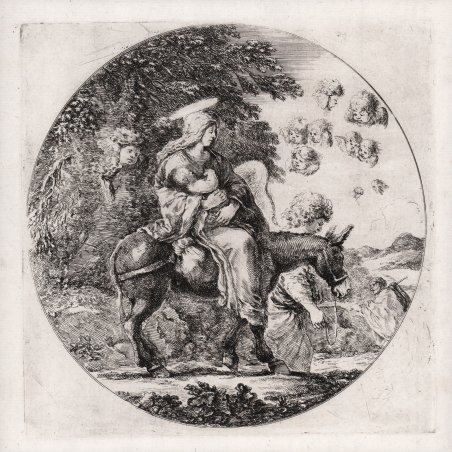Fuga in Egitto; la Vergine Maria con in braccio il Cristo bambino e seduta su un asino che viene condotto verso destra da un angelo, con San Giuseppe in basso a destra rivolto verso sinistra e con un fagotto sulle spalle, con cherubini in aria e alberi a sinistra; composizione circolare. ' Acquaforte, 1662 circa, firmata all'interno dell'immagine con il monogramma: "S.D.B.". Esemplare nel secondo stato di due, privo del tipico "effetto lavis" che caratterizza le primissime edizioni delle stampe di Della Bella, che tuttavia è parzialmente presente. Magnifica impressione, su carta vergata coeva, con margini, in ottimo stato di conservazione. Di questa incisione esistono disegni preparatori agli Uffizi e all'Ashmolean. Stefano della Bella fu uno degli incisori più interessanti e originali nella Firenze del XVII secolo e può considerarsi l’unico geniale continuatore dell’opera di Jacques Callot. La sua educazione artistica ebbe inizio a Firenze nella bottega degli orafi Gasparo Mola e Orazio Vanni, e la precisione del segno, tipica dell’arte orafa resterà caratteristica del suo stile. Studiò poi presso Giovanni Battista Vanni e forse anche presso il Cantagallina e Cesare Dandini, ma ben presto si dedicò all'incisione. Il suo vero maestro può considerarsi Jacques Callot, l’incisore francese che soggiornò a lungo a Firenze lasciando una forte impronta nel panorama artistico della città. Gli anni più importanti della sua carriera sono quelli che trascorre a Parigi, dal 1639 al 1650, stipendiato da Lorenzo de' Medici: lavorò insieme ad Israel Silvestre, con gli editori Langlois, Ciartres e Pierre Mariette, per stampatori francesi e per commissioni di gran prestigio, come quelle del 1641 per il cardinale Richelieu che gli affidò le illustrazioni delle sue imprese guerresche. Intorno al 1647, durante un viaggio in Olanda, dove eseguì le acqueforti con le vedute del porto di Amsterdam, incontrò Rembrandt e da quella data notiamo una eco profonda dell’arte dell’olandese nella grafica del Della Bella. Bibliografia De Vesme - Massar Stefano della Bella (1971) n. 13 II/II. Flight into Egypt; the Virgin Mary holding the infant Christ and seated on a donkey being led towards right by an angel, with St Joseph at lower right facing left and holding a bundle over his shoulder, with cherubs in the air and trees to left; in a circular composition. ' Etching, circa 1662, lettered within image with production detail: "S.D.B.". Example in the second state of two, without the typical "lavis effect" that characterizes the very first issues of Della Bella's prints, which, however, are partially present. A fine, early, impression on contemporary laid paper, with margins, in excellent condition. There are preparatory drawings for this etching in the Uffizi and the Ashmolean. Stefano della Bella was one of the most interesting and original engravers in 17th-century Florence and can be considered the only brilliant continuator of Jacques Callot's work. His artistic education began in Florence in the workshop of the goldsmiths Gasparo Mola and Orazio Vanni, and the precision of sign, typical of the goldsmith's art, will remain characteristic of his style. He then studied under Giovanni Battista Vanni and perhaps also under Cantagallina and Cesare Dandini, but soon turned to engraving. His real master can be considered Jacques Callot, the French engraver who stayed in Florence for a long time and left a strong imprint on the city's artistic scene. The most important years of his career were the ones he spent in Paris, from 1639 to 1650, salaried by Lorenzo de' Medici: he worked together with Israel Silvestre, with the publishers Langlois, Ciartres and Pierre Mariette, for French printers and for commissions of great prestige, such as those of 1641 for Cardinal Richelieu, who entrusted him with illustrations of his warlike exploits. Around 1647, during a trip to Holland, where he executed etchings with views of the port of Amsterdam, he met Rembrandt, and from that date we note a profound echo of the Dutchman's art in Della Bella's graphic work. Bibliografia De Vesme - Massar Stefano della Bella (1971) n. 13 II/II. Cfr.

Scopri come utilizzare
Scopri come utilizzare

